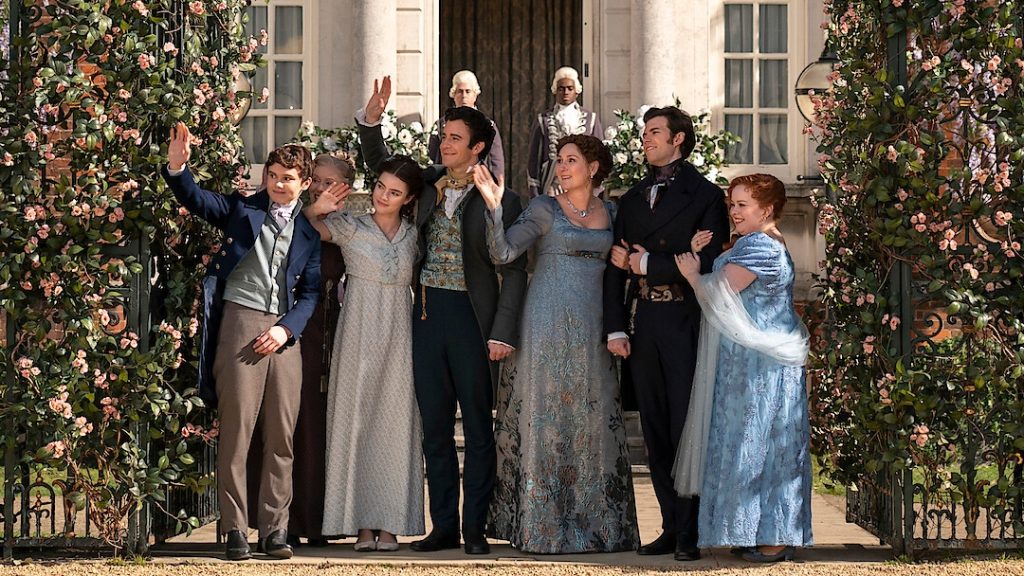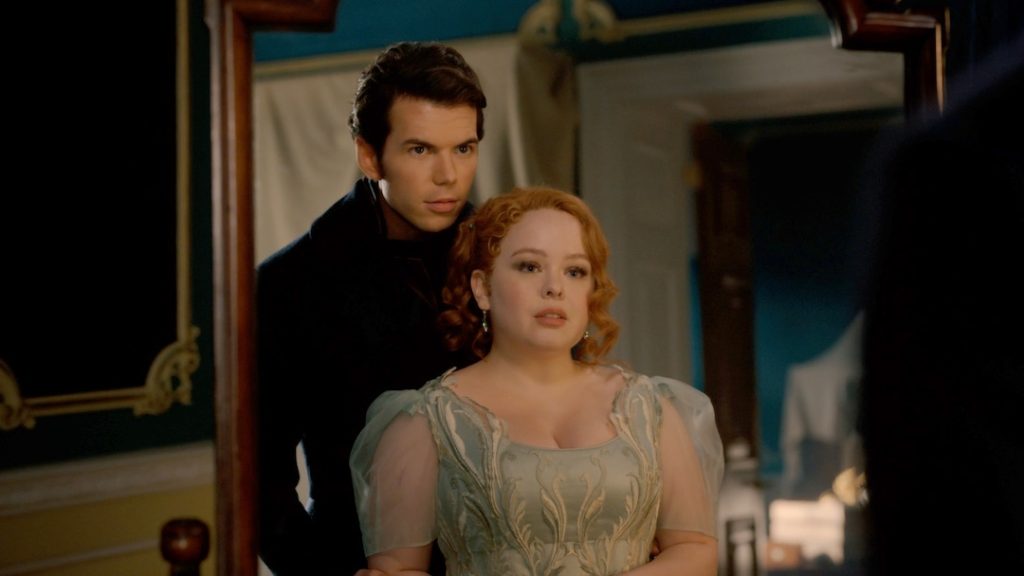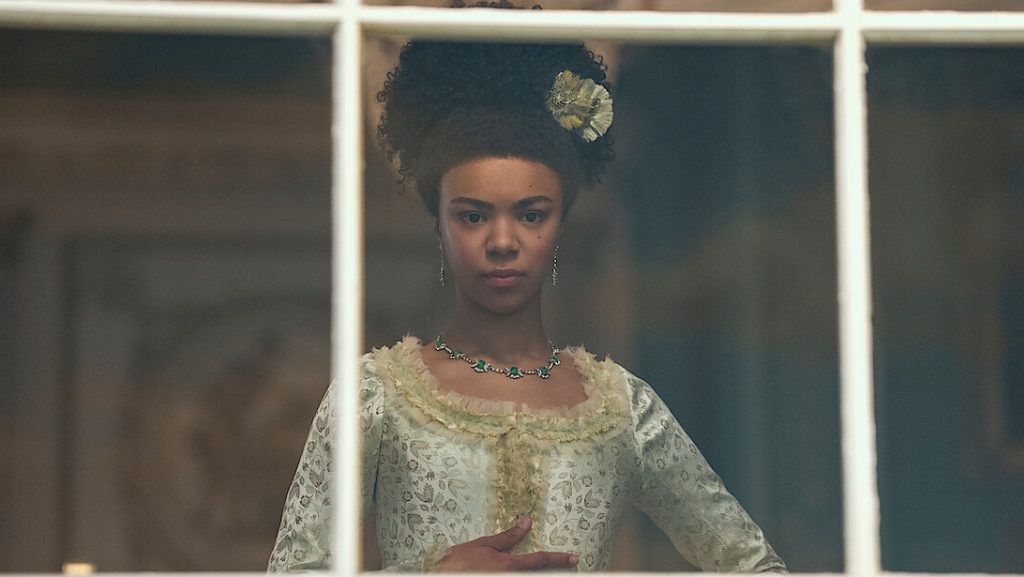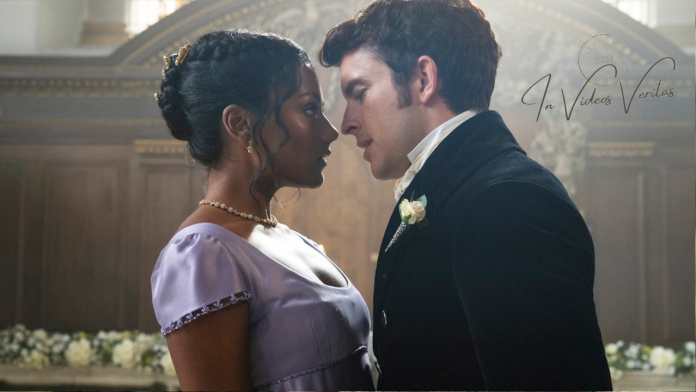Welcome to In Videos Veritas, where accuracy and artistic licence fight it out in the coliseum of audience experience.
Spoiler warning: This article contains spoilers for Bridgerton and Queen Charlotte: A Bridgerton Story.
The goal of this column is not to lambast a piece of media for failing to deliver perfect ‘historical accuracy’, something that is impossible to define, impossible to achieve, and rarely ever an acknowledged intention of the creators anyway. Nor is it my goal to overly praise works that feel authentic to their period but fall flat in other areas. So, what am I doing?, you may wonder. To put it simply: it’s interesting to explore how fact and fun interact, with an ultimate focus on what we are willing to include, embellish, or omit from the former in order to attain the latter.
This month, dearest reader, I’m taking a look at Bridgerton, Netflix and Shondaland’s wildly popular Regency-era romance series. Adapted from the book series of the same name by Julia Quinn, Bridgerton has been referred to in many different terms, as an alternate history, as a revisionist history, and as historical fanfiction. Much of this is due to the show’s expression of modern attitudes and sensibilities in regard to race, gender, and sexuality (though not particularly in regard to class), as well as the anachronistic costumes, makeup, and music.
The diverse casting is an integral part of the series, with the upper classes of Regency England reimagined as multicultural. In reality, according to Bridgerton’s historical consultant Hannah Greig, whilst there were “more diverse communities in London than period dramas often reveal”, they were “not all… living in the West End and always hanging out at the court of Queen Charlotte”. In the Bridgerton universe, Queen Charlotte is a Black woman, whose marriage to George III has ushered in a new era of acceptance (providing that you’re rich, of course). The implications of this inclusion are complex and nuanced, and have been covered extensively by writers with commentary more eloquent and insightful than I could hope to replicate. To read more on this topic, please consult the selected sources included below.
Surviving the Ton
Bridgerton is set in the Regency era, which is defined historically as the period from 1811 to 1820, but often culturally extends from 1795 to 1837. It was a tumultuous time, with the social and political climate of England changed forever by the French Revolution and the American Revolutionary War, as well as the ongoing Napoleonic Wars. It was also the era of Jane Austen, whose talents are still revered today, and whose works have inspired numerous authors including Julia Quinn.
It is perhaps the parts of the Regency era that figure prominently in Austen’s novels that have become synonymous with the era in public memory, and this is no less true of Bridgerton. Meddling mothers, naive debutantes, scandal, innuendo, etiquette, and plenty of parading about between drawing rooms, ballrooms and grand country piles abound.
In Bridgerton, almost all of the drama takes place during the Season, whilst the Ton are at their townhouses in London. Deriving from the French ‘le bon ton’ and translating roughly as ‘good taste’, the Ton was made up of the upper class families of ‘polite’ society. Each year, numerous members of these families took part in the Season, which, for young women, started with Queen Charlotte’s Birthday Ball in May. These young women, aged around seventeen or eighteen, would be presented to the Queen as a debutante, representing their ‘coming out’ into the wider world as an adult and as a marriageable prospect.
Bridgerton revels in these scenes, starting each series with the presentation of a Bridgerton daughter. However, the dresses worn by the debutantes in the show favour the elegant French tastes of the time, rather than the horrifically mismatched clashes of old and new styles insisted upon by the real Queen Charlotte. It is also worth noting that, while the concept of choosing a ‘diamond’ of the Season is entirely a confection of the book series, real debutantes would be scrutinised and the Queen’s reactions studied.
Debutantes would face intense pressure upon entering the ‘marriage mart’.They were expected to be graceful, well-dressed, and possess a sparkling wit; they must know how to dance and with whom; and they must have enough intelligence to learn a language, play an instrument, and learn to run a large household, but not so much that they risked intimidating the men around them. It was an impossible task, and one misstep could lead to social ruin, which Bridgerton emphasises in more than one storyline.
It is these parameters by which all the female characters are judged — Daphne and Edwina embrace them, Eloise and Kate attempt to exclude themselves, whilst Penelope and Francesca struggle to juggle their talent in one area with a perceived shortfall in another. “For a girl to miss out on a proposal in her first Season wasn’t quite the end of the world, but it was close”, and the huge personal toll this takes is evident in Penelope’s storyline in particular.
Gentlemen, on the other hand, could behave as badly as they liked, as long as they had the social standing to guarantee a title. Whilst, obviously, a ‘chivalrous’ man was favoured by society, the reverse was rarely punished. The limits to what a gentleman could get away with were on the extreme end — just look at Lord Byron — and they sharply contrasted the strict rules women were expected to abide by. Simon, Anthony, Benedict and Colin, all partake in behaviours that, if the women around them were to do the same, would result in abject disgrace for the entire family. Some of these behaviours were even encouraged or expected, such as Colin’s escapades on his Grand Tour.
However, if you were unlucky enough to find yourself in the middle of a public scandal, you wouldn’t find your full name printed in a bespoke scandal sheet delivered to the Ton on little silver plates. The taste for gossip was sated instead by newspaper and magazine columns, in which initials or pseudonyms might be used in order to dodge libel laws. A common way to assuage the effects of ruinous accusations was to “maintain a façade of normalcy” and continue with social engagements, much like the Bridgertons and the Sharmas attempt to do in season two.

Dressing the Ton
The aesthetic of Bridgerton has become one of its most unique and defining features. The sparkly, ostentatious gowns, paired with lashings of hair extensions, makeup, and jewellery, contributed to the ‘Regency-core’ boom of 2021, and have defined Bridgerton’s signature style ever since.
With each season, the costumes have departed further away from their historic inspiration. The creative team reached a sweet spot in series two, where most of the gowns preserved that iconic Regency empire-line waistline but enhanced the glamour with manufactured colours and sequin motifs. Sticking to that iconic silhouette preserved the immersion of the show in a way that has since been strained by the increasingly outlandish silhouettes, loose Hollywood curls, and even flashier makeup of series three.
Establishing consistent rules and logic for your setting, especially when it’s a different time period, helps your audience to suspend their disbelief. The established etiquette of the series is what enables us to gasp, entranced and scandalised, when Colin interrupts Penelope’s dance with Lord Debling. Having characters act and speak as if they are in Regency England, but dress as though they’re attending last month’s Met Gala, jeopardises this suspension and takes a little of the impact out of the drama. Being dazzled by the gorgeous fabrics and sparkling designs is a real joy, but spotting strappy kitten heels and dresses that wouldn’t look out of place at the Oscars is fast eroding the charm of Bridgerton’s alternate universe.

The Overlooked Queen
Bridgerton’s Queen Charlotte is one of the highlights of the show, becoming so popular for her cutting wit and wry comments that she garnered her own spin-off series. Bold, strong, and effortlessly entertaining, Bridgerton’s take on the overlooked queen consort shows her to be a staunch supporter of her husband, a stickler for strict etiquette, and a shrewd social mover with a huge amount of power.
The real Queen Charlotte, born Sophia Charlotte of Mecklenburg-Strelitz, was a more reserved character than her Bridgerton counterpart, hailing from a small German duchy with little political relevance. She did not meddle in politics, stayed out of the limelight, and was very good at having babies (producing fifteen in total!). In short, she was the model queen consort based on the ideals of the time.
Polly Putnam, the historical advisor for Queen Charlotte: A Bridgerton Story, refers to the show’s portrayal as “historical fan-fiction”, though much of what we see is inspired by real instances and events. The romance between Charlotte and George III is genuine, as by many accounts they were a happy, harmonious couple. Charlotte’s love of botany complemented George’s love of farming, and the pair shared a keen interest in music.

The tragedy of George’s illness, whilst handled with some sensitivity in the Bridgerton universe, is somewhat softened. In reality, George would become so intensely obsessed with Charlotte that she developed a genuine fear of her husband and would hide away from him when he suffered a relapse. It was said that the stress of this was so great that Charlotte’s hair turned white overnight. She clung to the comforting stability of rigid etiquette, keeping her court stagnant to contrast the unpredictability of her personal life, expressed via her outdated fashion sense in Bridgerton.
The seriousness of the Regency and the succession crisis is also downplayed in the Bridgerton universe. Whilst we do get to see Queen Charlotte attempting to protect the monarchy whilst lamenting the misdemeanours of her son, George IV, and the death of the heir to the throne, Princess Charlotte, we see little of the public unrest that accompanied this. England was on the brink of revolution, which is a large thing to ignore in a show so focused on the monarchy.
The Bridgerton Effect
On our screens more often than any other period, the Regency era is an eternally popular setting for media. We have abstracted it so extensively that much of the social unrest and conflict have been forgotten or brushed over in favour of indulging in the glamorous, leisurely lives of the upper classes. If history is a human construction based on the desire to produce an account of the past that “makes sense” to us now, then the world of Bridgerton is a construction designed to provide ultimate escapism.
Arriving on streaming at the perfect time during the pandemic, and unashamedly staying true to its lighthearted roots, Bridgerton has provided a glossy, beautiful world for viewers to escape to. In a television market often oversaturated with dark, violent, and cynical subject matter, Bridgerton remains a heartwarming exception that proves, ultimately, that romance isn’t dead.
In Videos Veritas rating:
Fact rating: 2/10
Fun rating: 9/10
Overall rating: 5.5/10
Words by Briony Havergill
Some selected sources and recommendations: Adapting Bridgerton: Essays on the Netflix Show in Context (Valerie Estelle Frankel, 2024); A Very British Romance with Lucy Worsley (television programme, 2015); BBC HistoryExtra (website); Becoming British, The Role of the Hanoverian Queen Consort (Joanna Marschner, 2020); Betwixt the Sheets: A History of Sex, Scandal, and Society (podcast, 2022-); Blackness, Dehumanized: A Black Feminist Analysis of ‘Bridgerton’ (Shaun Armstead, 2021); ‘Bridgerton’ Sees Race Through a Colorist Lens (Carolyn Hinds, 2021); Elegance and Decadence: The Age of the Regency (television programme, 2011); History is Sexy (podcast, 2018-); ‘I Get to Exist as a Black Person in the World’: Bridgerton as Speculative Romance and Alternate History on Screen (Piia K. Posti, 2024); Inside the World of Bridgerton: True Stories of Regency High Society (Catherine Curzon, 2023); Karolina Żebrowska; “Manners” Make the Man: Politeness, Chivalry, and the Construction of Masculinity, 1750–1830 (Michèle Cohen, 2005); Rex Factor (podcast, 2010-).
Support The Indiependent
We’re trying to raise £200 a month to help cover our operational costs. This includes our ‘Writer of the Month’ awards, where we recognise the amazing work produced by our contributor team. If you’ve enjoyed reading our site, we’d really appreciate it if you could donate to The Indiependent. Whether you can give £1 or £10, you’d be making a huge difference to our small team.
